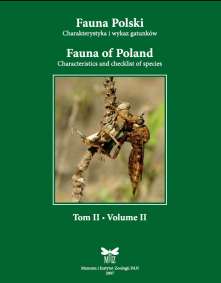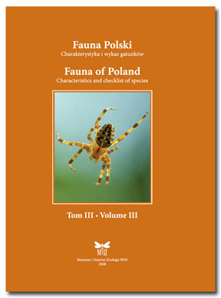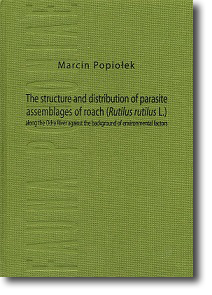Fauna of Poland - Characteristics and checklist of species
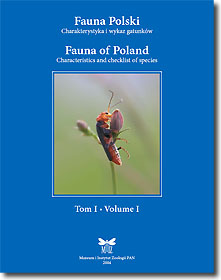 |
Volume I contents:: Annelida, Arthropoda pro parte, Insecta pro parte (Coleoptera, Hemiptera, Hymenoptera, Lepidoptera) Edited by: Wies³aw Bogdanowicz, El¿bieta Chudzicka, Irmina Pilipiuk, Ewa Skibiñska. Price (Volume I): 40 Euro + postage Format: 207 x 267 mm, hard cover, 509 pp. ISBN: 83-88147-04-8 OUT OF PRINT |
|
|
Volume II contents: Arthropoda pro parte,Insecta pro parte (Coleoptera, Hemiptera, Hymenoptera, Lepidoptera excluduntur) Entognatha Edited by: Wies³aw Bogdanowicz, El¿bieta Chudzicka, Irmina Pilipiuk, Ewa Skibiñska. Price (Volume II): 50 € + postage Format: 207 x 267 mm, hard cover, xx + 505 pp. ISBN: 978-83-881470-7-4 Orders: |
|
|
Volume III contents: Arthropoda pro parte (Chelicerata, Crustacea, Myriapoda) Acantocephala, Bryozoa, Cnidaria, Entoprocta, Gastrotricha, Mollusca, Nematoda, Nematomorpha, Nemertea, Platyhelminthes, Porifera, Rotifera, TardigradaEdited by: Wies³aw Bogdanowicz, El¿bieta Chudzicka, Irmina Pilipiuk, Ewa Price (Volume III): 40 € + postage Format: 207 x 267 mm, hard cover, xxxii + 603 pp. ISBN: 978-83-88147-09-8 Orders: |
The monograph, “Fauna of Poland – characteristics and checklist of species”, aims to be a source of comprehensive information on Polish faunal biodiversity, its value, and the current state of knowledge for individual taxa. The book lists all recent animal species reported from Poland (but generally excludes the fauna of the Baltic Sea), and describes all higher-order taxa, from phylum to family level. Summaries of knowledge of individual taxa in Poland are also provided and compared to what is known of their occurrence elsewhere.
The lists of species occurring in Poland are based on literature data and unpublished research by the respective authors, as well as on museum collections, many of which were subjected to a critical review for the purposes of this volume. The lists have been enriched with comprehensive biological and faunistic information, such as descriptions of the areas and habitats where a species occurs, abundance, habitat preferences, feeding habits, position in the trophic chain, as well as taxonomy and conservation status.
The Monograph will be published in four volumes (Vol. I, II & III - invertebrates, Vol. IV – vertebrates), each dealing with taxonomic groups of different ranks and sizes. It is addressed not only to zoologists of various specialties but also to naturalists in a broad sense of this word. The book should prove to be of use to nature conservationists, those working for national parks and landscape parks, quarantine services, and relevant authorities at all levels of state and local government. It should also prove valuable for teachers of biology at centres for biological education, secondary schools and universities.
Coleoptera Poloniae: Tenebrionoidea (Mycetophagidae, Ciidae, Mordellidae, Zopheridae, Meloidae, Pyrochroidae, Salpingidae, Anthicidae)
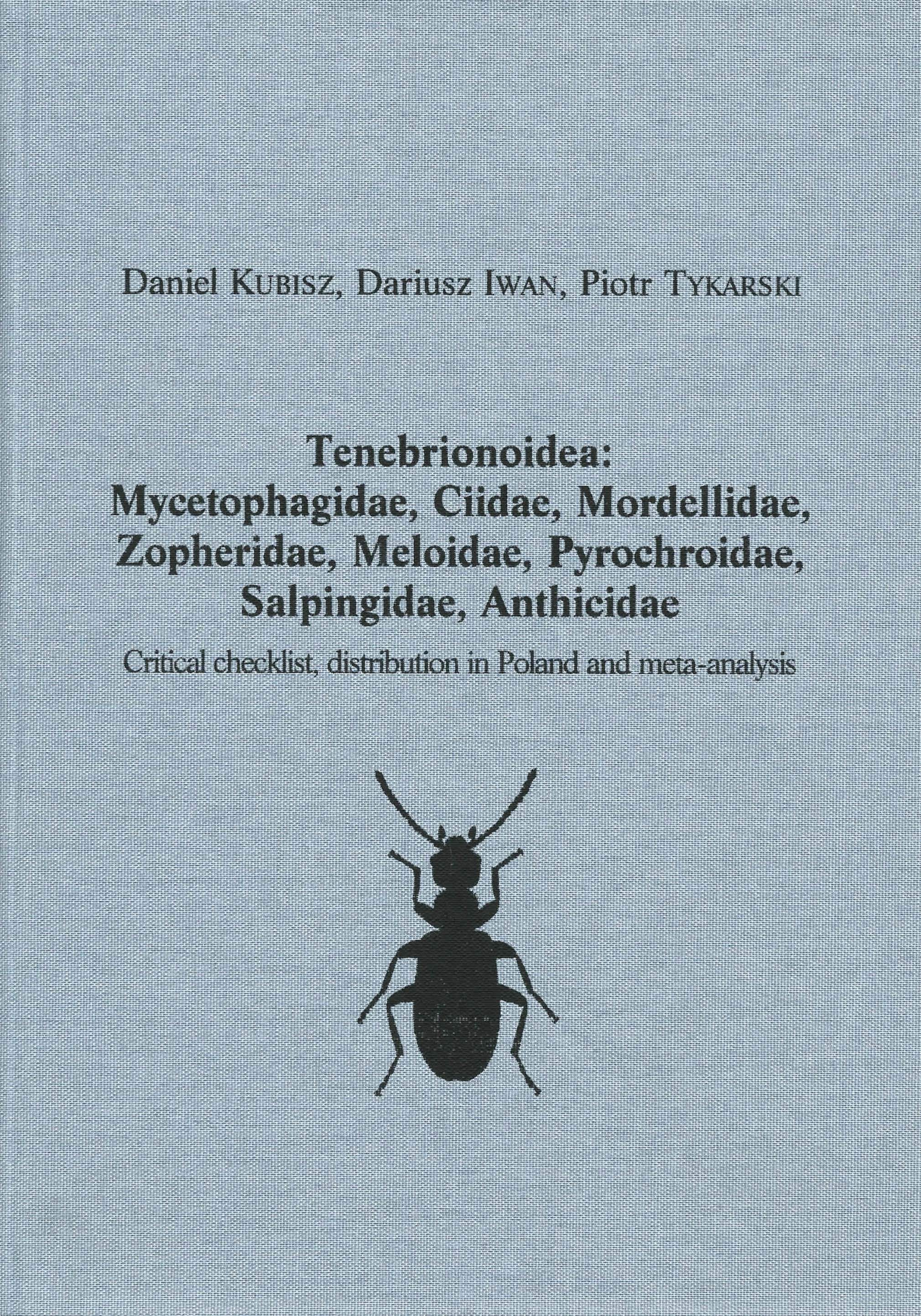 |
Critical checklist, distribution in Poland and meta-analysis Kubisz D., Iwan D., Tykarski P. 2015. Tenebrionoidea: Mycetophagidae, Ciidae, Mordellidae, Zopheridae, Meloidae, Pyrochroidae, Salpingidae, Anthicidae. (Coleoptera Poloniae vol. 3) University of Warsaw – Faculty of Biology, Hardcover, 176 x 250 mm, 744 pages, 403 figures, maps ISBN 978-83-942342-1-8 Price: 35 euro + 5% VAT + postage orders: Please contact This email address is being protected from spambots. You need JavaScript enabled to view it. |
Please contact our orders department This email address is being protected from spambots. You need JavaScript enabled to view it., or use online form (secure HTTPS connection)
Special Offer (save up to 70%)
Abstract
The book provides a summary of data on occurrence of Tenebrionidae and Boridae in Poland.
The presence of 73 species of Tenebrionidae and 1 Boridae species is confirmed, while 28
tenebrionid taxa are considered doubtful or needing confirmation, although reported in the past.
Data on distribution of the confirmed taxa cover localities, UTM 10x10 km grid coordinates,
dates, collections that hold specimen, and source references, accompanied by distribution maps
generalized to the UTM grid. A separate chapter gives an overview of Palaearctic distribution of all
the discussed taxa, including subspecies when applicable. Detailed taxonomic checklist of the group
including synonymy is also provided separately. The distribution catalogue part is followed by the
meta-analysis built upon a database covering all the presented information. A number of analytical
and generalization techniques was used, giving synthetic views on research intensity and number of
species known in different parts of the country, commonness-abundance relationship and relative
species richness fives a new quality to traditional faunistics, being paired with the database that will
be available online through the Biodiversity Map and Coleoptera Poloniae websites, served by the
Polish Biodiversity Information Network (KSIB).
Key words
Coleoptera, Tenebrionoidea, Tenebrionidae, Boridae, biodiversity, faunistics, zoogeography,
distribution, meta-analysis, checklist, museum collections, Poland
Catalogus Faunae Poloniae - New series - vol. 3 Plant bugs of Poland. Part II. Subfamily Mirinae
 |
Jacek Gorczyca, Andrzej Wolski Warszawa 2011 ISBN 978-83-930773-3-5 ISSN 1895-5614 Publisher:
|
Abstract
The second part of the catalogue of plant bugs of Poland is presented. It contains 105 species of mirid subfamily Mirinae reported from Poland. All published data are provided, from the oldest WEIGEL’S report to the last faunistic papers. Unpublished data are also included. The current taxonomical status, biology, distribution of species as well as their economic importance are provided. Keys to the tribes and genera of the subfamily are given. The classification system follows the series of the Catalogue of the Heteroptera of the Palaearctic Region.
Keywords
catalogue, faunistics, Heteroptera, Miridae, Mirinae, Poland.
Fauna Polski - Nowa seria - vol. 5 - The structure and distribution of parasite assemblages of roach (Rutilus rutilus L.)
|
|
Marcin Popiołek The structure and distribution of parasite assemblages of roach (Rutilus rutilus L.)
Museum and Institute of Zoology of the Polish Academy of Sciences Warszawa 2012 175 x 245 mm, 295 pages, twarda okładka, ISBN 978-83-930773-6-6 ISSN 0303-4909 |
Price: 60 euro + 5% VAT + postage
Orders:
Please contact our orders department This email address is being protected from spambots. You need JavaScript enabled to view it., or use online form (secure HTTPS connection)
Celem badań było wykazanie wielokierunkowego wpływu czynników środowiskowych (naturalnych i antropogennych) na rozmieszczenie oraz strukturę zgrupowań pasożytów płoci (Rutilus rutilus L.) wzdłuż biegu Odry. Analizowane czynniki podzielono na dwie grupy. Do czynników środowiskowych zaliczono: (1) charakter rzeki, (2) poziom uprzemysłowienia terenów przy-ległych, (3) obecność lub brak sztucznych przegród w korycie rzeki, (4) obecność lub brak gospodarstw rybackich, (5) bogactwo ostoi ptaków wodno-błotnych w sąsiedztwie rzeki oraz (5) szybkość nurtu. Wśród czynników fizyko-chemicznych wyróżniono grupy parametrów charakteryzujących: (1) warunki fizyczne i termiczne wody, (2) warunki tlenowe i zanieczyszczenia organiczne, (3) zasolenie, (4) zakwaszenie oraz (5) warunki biogenne. Na siedmiu stanowiskach zlokalizowanych wzdłuż całego, mierzącego 854 km, biegu Odry odłowiono łącznie 451 płoci, które poddano pełnym sekcjom parazytologicznym.
Słowa kluczowe: Pasożyty, Rutilus rutilus, płoć, Odra, zgrupowania pasożytów, czynniki środowiskowe, Polska.
Fauna Mundi - vol. 4 - Ptyctimous mites (Acari: Oribatida) of the Palaearctic Region
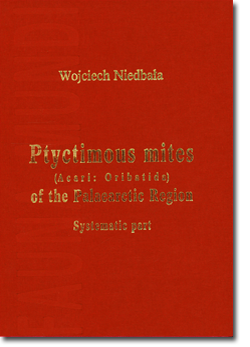 |
Wojciech Niedbała Warsaw 2011 165 x 235 mm, hardcover, 472 pages, 189 figures plates ISBN 978-83-930773-2-8, ISSN 2081-4615 Publisher:
|
Abstract
On the basis of morphological features a systematic analysis was made of 293 species and two subspecies from the Palaearctic region, belonging to following groups of ptyctimous mites: Protoplophoridae – 15 species, Archoplophoridae – one species, Mesoplophoridae – five species, Apoplophoridae – three species, Euphthiracaroidea – 93 species and two subspecies and Phthiracaroidea – 176 species. For each species a diagnosis was given accompanied by a differentiating analysis between the closest related species.
For five genera and subgenera stat. nov. was proposed, 15 species and five subspecies were treated as syn. nov.; 12 type species and one subspecies were redescribed on the basis of type material.
A chorotype, i.e. geographical range of each species was established.
Keys for identification of cohorts, families, genera, subgenera and species were prepared. As many as 35 species were classified as species inquirendae.
Twenty six species originating from other zoogeographical regions have been introduced to Palaearctic in Prooriental and East-Asiatic parts. The number of wide-distributed species was found to be rather high – 45, including semicosmopolitan, Holarctic and Panpalaearctic ones. Eight species were established to be somewhat less wide-distributed in some parts of the Palaearctic. Over two thirds of the total number of species, that is 215 species were proved to be relatively narrowly distributed and 115 of them were endemic.
Keywords
Acari, Oribatida, Ptyctima, Palaearctic, systematic






